Audi e-tron Spyder concept 2010
Audi presents the Audi e-tron Spyder, the study of an open sports car, at the fall 2010’s largest auto show. The show car, with plug-in hybrid drive, is 4.06 meters (13.32 ft) long, 1.81 meters (5.94 ft) wide and only 1.11 meters (3.64 ft) high. The two-seater is equipped with a 221-kW (300-hp) twin-turbo V6 TDI at the rear axle and two electric motors producing a total of 64 kW at the front axle.
The Audi e-tron Spyder’s low total weight of only around 1,450 kilograms (3,196.70 lb) combined with the high-torque TDI and the two electric motors results in respectable performance. The car accelerates to 100 km/h (62.14 mph) in just 4.4 seconds, and top speed is electronically governed at 250 km/h (155.34 mph).
The e-tron Spyder can combine the powerful torque of its TDI – the diesel engine generates 650 Nm (479.42 lb-ft) and the total of 352 Nm (259.62 lb-ft) of its two electric motors during acceleration in a process known as “boosting.”
The intelligent distribution of power allows for optimal dynamics in every situation. The targeted application of power to the front wheels improves longitudinal dynamics while also improving lateral dynamics when cornering.
The combination of a highly efficient TDI and electric drive also provides for excellent fuel economy and amazingly low emissions. The Audi e-tron Spyder requires on average just 2.2l diesel/100 km (106.92 US mpg), corresponding to CO2 emissions of 59 g/km (94.95 g/mile). A range of more than 1,000 kilometers is possible with the 50-liter (13.21 US gallons) tank.
The open sports car can also drive strictly on electric power and thus with zero emissions over distances of up to 50 kilometers (31.07 miles), such as in urban areas. The top speed of 60 km/h (37.28 mph) is just fine for normal driving.
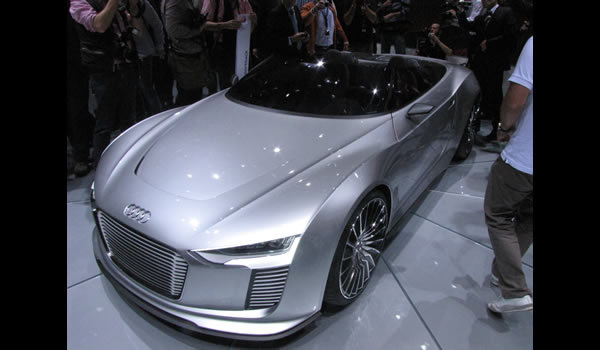 |
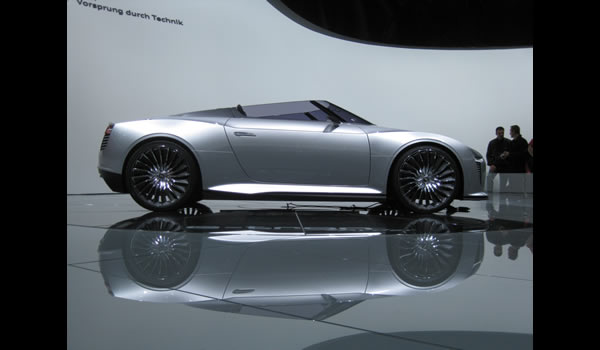 |
The Audi e-tron Spyder features what is without a doubt the most advanced and simultaneously the most consistent evolution of the current Audi design language, while also providing initial hints at the design language of future Audi sports cars. It reinterprets the most important design elements that already characterized the previous e-tron concept vehicles. This also ensures the necessary formal differentiation to the purely electric-powered Audi e-tron shown at the 2010 Detroit Motor Show.
1.81 meters (5.94 ft) wide, just 4.06 meters (13.32 ft) long and only 1.11 meters (3.64 ft) in height: these are the classic proportions of an open, high-performance sports car. Compared to the coupé concept car in Detroit, the length and width have increased by 13 cm (5.12 in) and 3 cm (1.18 in), respectively, to underscore the sporty aspiration of the design. This further enhanced the powerful and compact overall appearance that characterizes both vehicles and links them to the sportiest production Audi, the R8.
Another element borrowed from race cars characterizes the hood: the wide central air inlet, whose curve further accentuates the dynamics of the car’s front end and provides a visual and functional link to the Audi R8 LMS customer race car. The carbon application that is mounted flush in the front and side windows and wraps completely around the glass testifies to the design and manufacturing expertise that went into the car.
The front the silhouette of the e-tron Spyder are characterized by a sharp, sweeping line that immediately identifies the two-seater as an Audi. The sharply tapered front end lends the Audi e-tron Spyder show car a distinctly wedge-like basic shape. The trapeze of the single-frame grille dominates the distinctly wedge-shaped front end and is flanked by two large air intakes. They serve as cooling intakes for the electric drive system and also for the TDI engine at the rear of the vehicle.
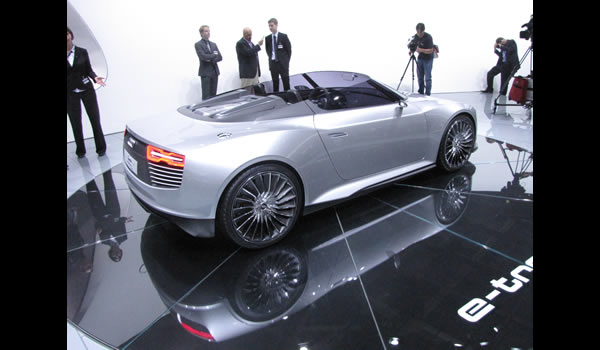 |
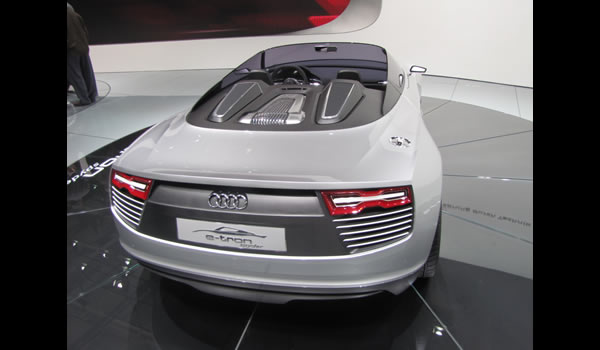 |
All light units use ultra-efficient LED technology. As with the R8 and the e-tron sports car concept cars, the trademark four rings are located above the single-frame. Beneath the trademark is the charging station for the batteries. The rings disappear beneath the front hatch, exposing not just the charging plug but also a display showing the charge state and a map graphic indicating the current electric range.
Visual and functional references to the fundamental concept of lightweight construction characterize the purist interior design. They establish a connection between proven Audi genes and new formal hallmarks. Typical for the Audi design idiom is the reduction of the architecture, controls and information output to the essentials in favor of a tidy overall impression.
Systematic lightweight construction is a crucial prerequisite for efficiency and range, while also being the primary foundation for exhilarating driving dynamics. The Audi development engineers drew on the core competence of the company for the Audi e-tron Spyder. The body structure is based on Audi Space Frame (ASF) technology and was realized as a hybrid construction, with the hood and numerous aerodynamic components made of carbon.
In ASF technology, the body's supporting structure is made of extruded aluminum sections and die-castings. Aluminum panels are incorporated into this skeleton to form a positive connection and perform a load-bearing role. Each individual component of the ASF space frame is optimized for its specific task by the use of widely differing shapes and cross-sections, combining maximum stability with minimal weight. Despite the complex drive system layout with two electric motors and their respective drive systems plus the TDI engine, the Audi e-tron Spyder show car only weighs around 1,450 kilograms (3,196.70 lb).
Audi has long proven the perfect synthesis between a highly advanced sports car and TDI technology. With the TT, Audi become one of the first manufacturers anywhere in the world to successfully bring a diesel sports car to market, a decade after the Audi Cabriolet paved the way for diesel engines in this segment. And the Audi R8 TDI Le Mans concept car was the first supercar to be fitted with a twelve-cylinder diesel engine with 500 hp and 1,000 Newton meters (737.56 lb-ft) of torque.
The Audi e-tron Spyder also draws on this recipe for success – albeit in a revolutionary new combination. This marks the first use of a new generation of the six-cylinder, 3.0 TDI that breathes through two turbochargers and produces 221 kW (300 hp). |
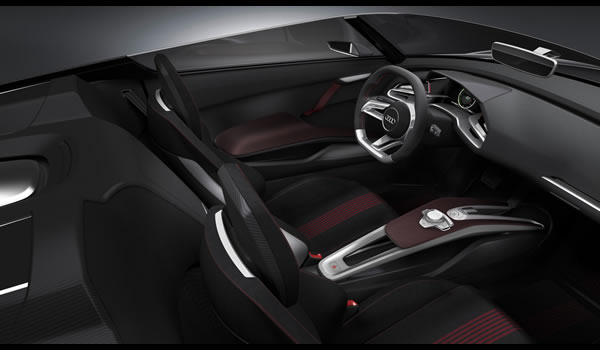 |
Peak torque of 650 Newton meters (479.42 lb-ft) is unusually high, even in the sports car segment. The mid-mounted, longitudinal 3.0 TDI engine drives the rear wheels via a seven-speed dual-clutch transmission.
Another innovation is the coupling of the TDI with the electric drive of the front axle. Two asynchronous electric motors with a total output of 64 kilowatt (88 hp) and peak torque of 352 Newton meters (259.62 lb-ft) combine with the 3.0 TDI to give the Audi e-tron Spyder the performance of a high-performance sports car. It accelerates from 0 to 100 km/h (62.14 mph) in 4.4 seconds. Top speed is electronically governed at 250 km/h (155.34 mph).
The full-hybrid Audi e-tron Spyder has mastered the discipline of zero-emission driving. In residential and other urban areas, the driver can activate the electric drive by itself. The 9.1-kwH battery at the front of the car has enough power for up to 50 kilometers (31.07 miles). And with a top speed of up to 60 km/h (37.28 mph), the e-tron Spyder is also able to move along smartly in city traffic.
Wallpapers: Audi e-tron Spyder concept 2010
|